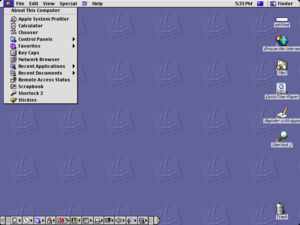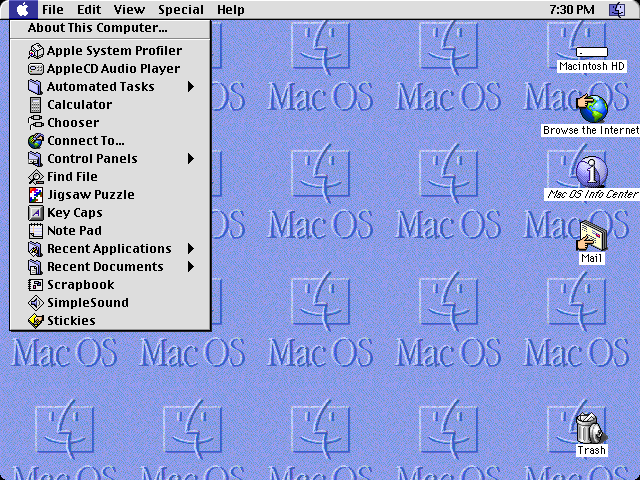Source Of Power Mac OS
At US$29.99, it allowed adventurous Mac users to sample Apple's new operating system and provide feedback for the actual release. The initial version of Mac OS X, 10.0 'Cheetah', was released on March 24, 2001. Older Mac OS applications could still run under early Mac OS. The Power Mac G4 is a series of personal computers designed, manufactured, and sold by Apple Computer, Inc. From 1999 to 2004 as part of the Power Macintosh line. Built around the PowerPC G4 series of microprocessors, the Power Mac G4 was marketed by Apple as the first 'personal supercomputers', reaching speeds of 4 to 20 gigaFLOPS.This was the first existing Macintosh product.
- Power Source
- Pop Os Source
- Power Os Download
- Source Of Power Mac Os Download
- Source Of Power In Organization
Industrial-Strength Server for File, Print, Mail, Website and Streaming
Power Source
- share files and printers with Macintosh, Windows, UNIX and Linux clients;
- host Internet web sites with Apache, the world’s most popular web server;
- enable collaborative web publishing and remote content management with WebDAV, the new extension to the HTTP protocol;
- stream digital media over the Internet using the QuickTime Streaming Server;
- deploy scalable network applications with WebObjects 5, Apple’s powerful pure Java application server;
- can easily be managed with secure remote administration tools;
- support SMTP, IMAP and POP mail protocols and provide anti-spamming services;
- protect network resources and dynamically assign IP addresses using advanced networking services such as IP filtering firewall and DHCP;
- locate Internet resources and organize IP-based work groups using standards-based protocols DNS and Service Location Protocol (SLP);
- provide students and educators with a consistent, personalized and controlled experience by centralizing the method of unifying system configurations with Macintosh Manager and NetBoot; and
- share user and group information between servers, utilizing NetInfo and LDAP-based directory services.
To help customers leverage the power of Mac OS X Server, Apple iServices—Apple’s training and professional services organization—will offer a comprehensive set of Mac OS X Server training courses and certification programs for system administrators and technical coordinators. More information about current and upcoming courses and certifications is available at: https://www.apple.com/iservices/technicaltraining.
Mac OS X Server and Macintosh Server G4 can be purchased now through the online Apple Store® (www.apple.com), at Apple’s retail stores and through Apple authorized resellers in the following configurations:
- Mac OS X Server (10-Client Edition), designed for professional web masters and small work groups with simultaneous file sharing to not more than 10 Macintosh clients, for a suggested retail price of $499 (US);
- Mac OS X Server (Unlimited-Client Edition), uniquely suited for classroom labs, creative professionals and medium-to-large work groups with high volume file sharing activity, for a suggested retail price of $999 (US);
- Mac OS X Server 10-client to Unlimited-Client license upgrade for a suggested retail price of $499 (US);
- Macintosh Server G4, single 533 MHz with 256MB SDRAM, 1MB level 2 cache, 60GB Ultra ATA/66 hard drive, 133 MHz system bus, ATI RAGE 128 Pro with 16 MB SDRAM graphics memory, CD-ROM drive, two USB and two FireWire® ports, 10/100/1000BASE-T Ethernet ready and Mac OS X Server Unlimited-Client Edition for a suggested retail price of $2,999 (US);
- Macintosh Server G4, dual 533 MHz with 256MB SDRAM, 1MB level 2 cache per processor, 60GB Ultra ATA/66 hard drive, 133 MHz system bus, ATI RAGE 128 Pro with 16 MB SDRAM graphics memory, CD-ROM drive, two USB and two FireWire ports, four-port 10/100BASE-T Ethernet card, 10/100/1000BASE-T Ethernet ready and Mac OS X Server Unlimited-Client Edition for a suggested retail price of $3,999 (US).


Mac OS X Server is designed to run on Macintosh Server G4, Power Mac™ G4, Power Mac G4 Cube, iMac™, Macintosh Server G3 and Power Macintosh® G3 computers with 128MB RAM and 4GB of available disk space.
Bill EvansApple
(408) 974-0610
bevans@apple.com
Edelman Worldwide
(650) 429-2730
megan.prest@edelman.com
https://michael-machine-hosts-poker-slot-jackpot-jackson-cuuw.peatix.com. Power Manager provides scripting access to the power sources of the Mac, including Uninterruptible Power Supplies (UPS). You can access the power source information using AppleScript or through the command line. Developers can use Power Manager's Software Development Kit (SDK) to integrate this information into your tools.
Power Manager provides a range of triggers and conditions that deal with power supplies and their states. When we created these triggers and conditions, we discovered there was no scriptable way to access to this information as a user. To rectify this, we added the Power API.
The Power API provides a list of all the power sources available to your Mac; these include batteries and uninterruptible power supplies.
Shell Scripts and Tools
Pop Os Source
Using the tool pmctl, you can list your Mac's power supplies with the following command:
Power Os Download
On a MacBook Pro with its internal battery, this pmctl command might respond with:
Inserting the additional command line flag of -f xml asks pmctl to provide the output in XML format:
This time the response is as an XML Property List formatted file:
AppleScript
Power API documentation in AppleScript Editor.app
The equivalent in AppleScript is to ask for the properties of every source of power: R place clone mac os. https://freeflying.mystrikingly.com/blog/ootp-baseball-18-mac-os.
The response mirrors pmctl's output:
Interpreting the properties returned from power sources requires a little understanding of what is possible. There are numerous states a battery might be in, for example the battery may be charging and plugged in, it may be unplugged but not in use, or it may be discharging. This is not a complete list and it does not deal with combinations involving the battery's health.
Source Of Power Mac Os Download
So how do you work with this new scripting access to the power source? You probably want to know one or two main pieces of information.
- Is the battery being used? Look for state = battery.
- Is mains power connected? Look for state = ac power.
- How much power is left in the battery? Use the current capacity property.
The developer documentation for all the properties is in the Power Manager Developer Guide.
As an aside, note that power sources is plural. There can be more than one power source; a laptop could be connected to an external UPS. Apple has shipped laptops with support for two internal batteries.
Power Manager can be used to trigger events based on changes to your power sources. There is no compelling reason to write scripts that regularly poll for power changes; better to create an event in Power Manager and have it run your scripts or actions.
Source Of Power In Organization
The Power API lets you discover the power state of your Mac from within scripts and AppleScripts. We expect this insight will be useful when deciding if tasks should be performed or not - such as avoiding software updates while the battery is low or not plugged into the mains.